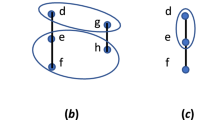Abstract
We establish some of the basic model theoretic facts about the Gurarij operator system GS recently constructed by the second-named author. In particular, we show: (1) GS is the unique separable 1-exact existentially closed operator system; (2) GS is the unique separable nuclear model of its theory; (3) every embedding of GS into its ultrapower is elementary; (4) GS is the prime model of its theory; and (5) GS does not have quantifier-elimination, whence the theory of operator systems does not have a model companion. We also show that, for any q ∈ ℕ, the theories of Mq-spaces and Mq-systems do have a model companion, namely the Fra¨ıssé limit of the class of finite-dimensional Mq-spaces and Mq-systems respectively; moreover, we show that the model companion is separably categorical. We conclude the paper by showing that no C* algebra can be existentially closed as an operator system.
Similar content being viewed by others
References
I. Ben Yaacov, Fraissé limits of metric structures, Journal of Symbolic Logic 80 (2015), 100–115.
I. Ben Yaacov, A. Berenstein, C. W. Henson and A. Usvyatsov, Model theory for metric structures, in Model theory with Applications to Algebra and Analysis. Vol. 2, London Mathematical Society Lecture Note Series, Vol. 350, Cambridge University Press, 2008, p. 315–427.
I. Ben Yaacov and C. W. Henson, Generic orbits and type isolation in the Gurarij space, Fundamenta Mathematicae 237 (2017), 47–82.
I. Ben Yaacov and T. Tsankov, Weakly almost periodic functions, model-theoretic stability, and minimality of topological groups, Transactions of the American Mathematical Society 368 (2016), 8267–8294.
I. Ben Yaacov and A. Usvyatsov, Continuous first order logic and local stability, Transactions of the American Mathematical Society 362 (2010), 5213–5259.
B. Blackadar, Operator Algebras, Encyclopaedia of Mathematical Sciences, Vol. 122, Springer-Verlag, Berlin, 2006.
D. P. Blecher and C. Le Merdy, Operator Algebras and their Modules—an Operator Space Approach, London Mathematical Society Monographs, New Series, Vol. 30, Oxford University Press, Oxford, 2004.
D. P. Blecher and M. Neal, Metric characterizations of isometries and of unital operator spaces and systems, Proceedings of the American Mathematical Society 139 (2011), 985–998.
N. P. Brown and N. Ozawa, C*-algebras and Finite-dimensional Approximations, Graduate Studies in Mathematics, Vol. 88, American Mathematical Society, Providence, RI, 2008.
M. D. Choi, Completely positive linear maps on complex matrices, Linear Algebra and its Applications 10 (1975), 285–290.
C. J. Eagle, I. Farah, E. Kirchberg and A. Vignati, Quantifier elimination in C*-algebras, International Mathematical Research Notices, in press.
I. Farah, B. Hart, M. Lupini, L. Robert, A. Tikuisis, A. Vignati and W. Winter, Model theory of C*-algebras, Memoirs of the American Mathematical Society, in press.
I. Goldbring, B. Hart and T. Sinclair, The theory of tracial von Neumann algebras does not have a model companion, Journal of Symbolic Logic 78 (2013), 1000–1004.
I. Goldbring and T. Sinclair, On Kirchberg’s embedding problem, Journal of Functional Analysis 269 (2015), 155–198.
I. Goldbring and T. Sinclair, Omitting types in operator systems, Indiana University Mathematical Journal 66 (2017), 821–844.
V. I. Gurariĭ, Spaces of universal placement, isotropic spaces and a problem of Mazur on rotations of Banach spaces, Siberian Mathematical Journal 7 (1966), 1002–1013.
U. Haagerup and S. Thorbjørnsen, A new application of random matrices: Ext(C* red(F2)) is not a group, Annals of Mathematics 162 (2005), 711–775.
D. Hadwin, Strongly quasidiagonal C*-algebras, Journal of Operator Theory 18 (1987), 3–18.
K. H. Han and V. I. Paulsen, An approximation theorem for nuclear operator systems, Journal of Functional Analysis 261 (2011), 999–1009.
M. Junge and G. Pisier, Bilinear forms on exact operator spaces and B(H) ⊗ B(H), Geometric and Functional Analysis 5 (1995), 329–363.
D. Kerr and H. Li, On Gromov–Hausdorff convergence for operator metric spaces, Journal of Operator Theory 62 (2009), 83–109.
W. Kubiś and S. Solecki, A proof of uniqueness of the Gurariĭ space, Israel Journal of Mathematics 195 (2013), 449–456.
F. Lehner, Mn-espaces, sommes d’unitaires et analyse harmonique sur le groupe libre, Ph.D. thesis, Université de Paris 6, 1997.
M. Lupini, Operator space and operator system analogs of Kirchberg’s nuclear embedding theorem, Journal of Mathematical Analysis and Applications 431 (2015), 47–56.
M. Lupini, Uniqueness, universality, and homogeneity of the noncommutative Gurarij space, Advances in Mathematics 298 (2016), 286–324.
M. Lupini, A universal nuclear operator system, arXiv:1412.0281.
W. Lusky, The Gurarij spaces are unique, Archiv der Mathematik 27 (1976), 627–635.
T. Oikhberg, The non-commutative Gurarii space, Archiv der Mathematik 86 (2006), 356–364.
N. Ozawa, About the Connes embedding conjecture: algebraic approaches, Japanese Journal of Mathematics 8 (2013), 147–183.
V. Paulsen, Completely Bounded Maps and Operator Algebras, Cambridge Studies in Advanced Mathematics, Vol. 78, Cambridge University Press, Cambridge, 2002.
G. Pisier, Exact operator spaces, Astérisque 232 (1995), 159–186
G. Pisier, Introduction to Operator Space Theory, London Mathematical Society Lecture Note Series, Vol. 294, Cambridge University Press, Cambridge, 2003.
Z.-J. Ruan, Subspaces of C*-algebras, Journal of Functional Analysis 76 (1988), 217–230.
R. R. Smith, Completely bounded maps between C*-Algebras, Journal of the London Mathematical Society s2-27 (1983), 157–166.
B. Xhabli, The super operator system structures and their applications in quantum entanglement theory, Journal of Functional Analysis 262 (2012), 1466–1497.
Author information
Authors and Affiliations
Corresponding author
Additional information
Goldbring’s work was partially supported by NSF CAREER grant DMS-1349399. Lupini’s work was supported by the York University Susan Mann Dissertation Scholarship and by the ERC Starting grant no. 259527 of Goulnara Arzhantseva. This work was initiated during a visit of the second author to the University of Illinois at Chicago. The hospitality of the UIC Mathematics Department is gratefully acknowledged.
Rights and permissions
About this article
Cite this article
Goldbring, I., Lupini, M. Model-theoretic aspects of the Gurarij operator system. Isr. J. Math. 226, 87–118 (2018). https://doi.org/10.1007/s11856-018-1691-3
Received:
Revised:
Published:
Issue Date:
DOI: https://doi.org/10.1007/s11856-018-1691-3



